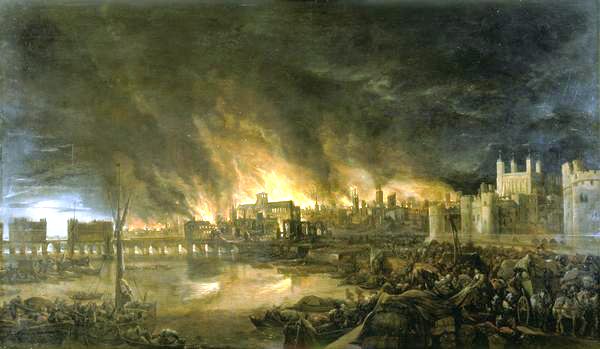The 1666 London Fire, famously known as the Great Fire of London, resulted in a catastrophic event that had lasting impacts on the city’s architecture, infrastructure and society. This devastating fire not only caused immense destruction but also led to significant changes in architecture, infrastructure, and society.
In this blog post, we will delve deep into various aspects of the 1666 London Fire. We’ll explore its causes and extent of damage while shedding light on how it impacted London’s history. Furthermore, we’ll discuss how this historical event has been portrayed in popular culture through art, literature, reenactments, commemorations and its cultural significance today.
As we move forward with our exploration of the aftermath of the fire, you’ll learn about rebuilding efforts and new regulations that emerged following this disaster. Additionally, we will introduce some notable people involved in the events surrounding the fire such as Thomas Farriner – Baker of Pudding Lane; King Charles II who played an essential role in rebuilding efforts; and Samuel Pepys – Diarist & Civil Servant.
Finally, we will reflect upon the legacy left by this transformative event on modern-day London including preservation efforts for historical sites related to the Great Fire along with educational resources available for learning more about it.
Table of Contents:
- Overview of the 1666 London Fire
- Causes of the Fire
- Extent of the Damage
- Impact on London’s History
- The Great Fire of London in Popular Culture
- The Aftermath of the 1666 London Fire
- Notable People Involved in the 1666 London Fire
- Legacy of the 1666 London Fire
- Frequently Asked Questions 1666 London Fire
- Conclusion
1. Overview of the 1666 London Fire
Exploring the causes, extent and damage of the 1666 London Fire as well as its long-term effects on the city will be discussed in this section.
Causes of the Fire
The Great Fire began on September 2nd, 1666, in a bakery located on Pudding Lane. The baker Thomas Farriner failed to extinguish his oven properly before going to bed which led to sparks igniting nearby wooden structures. With most buildings made from timber and tightly packed together within narrow streets, it created an ideal environment for flames to spread rapidly across neighborhoods.
Dry Weather Conditions
In addition to flammable building materials and close proximity between structures, another factor contributing significantly towards spreading fire was dry weather conditions prevailing during that period. The summer months leading up-to September had been unusually hot with little rainfall making everything parched & susceptible for catching fires easily.
Extent of the Damage
The inferno raged for four days straight causing widespread destruction throughout central parts including over 13 thousand houses,87 parish churches, and several iconic landmarks such as St Paul’s Cathedral were reduced into ashes leaving around 70 thousand people homeless out of total population estimated around eighty thousand residents living there back then .
- Area Destroyed: The fire consumed an area of approximately 436 acres, stretching from the Tower of London in the east to Fleet Street and Temple Church in the west.
- Economic Losses: It is estimated that the total cost of damages caused by this disaster was around £10 million (equivalent to over £1 billion today).
Impact on London’s History
The Great Fire left a profound mark on London’s history as it forced city planners & authorities into reconsidering their approach towards urban planning, building regulations, and infrastructure development. This event ultimately led to modernization with new architectural styles being introduced while replacing old wooden structures having brick or stone buildings which were more resistant against fires.
In addition, it also prompted significant advancements within firefighting techniques including establishment of professional fire brigades equipped with advanced tools like leather hoses & hand-operated pumps capable for extinguishing blazes effectively before they could escalate further out-of-control.
The aftermath witnessed extensive rebuilding efforts under supervision from King Charles II who played a pivotal role during recovery phase ensuring his subjects received necessary support required for getting back onto their feet after such devastating calamity had struck them unawares.The Great Fire remains an important chapter within British history as its lessons continue shaping our understanding about urban resilience even till date.
The 1666 London Fire was an unforgettable calamity that left a permanent imprint on the city’s narrative. Moving forward, it is important to consider how this historic fire has been represented in popular culture over time.
Key Takeaway: The 1666 Great Fire of London caused immense destruction, leaving many without a home and billions in losses. Charles II played an instrumental role during the recovery phase, ensuring citizens had all necessary support to get back on their feet after such a crushing blow. The fire left lasting lessons about urban resilience which are still applicable today.
2. The Great Fire of London in Popular Culture
The 1666 London Fire has left an indelible mark on popular culture, with its dramatic events and lasting impact inspiring various forms of art, literature, and commemorative events. From paintings to novels and even modern-day reenactments, the Great Fire continues to captivate audiences around the world.
Depictions in Art and Literature
One of the most famous artistic representations of the fire is “The Burning of Old London Bridge”, a painting by Claude de Jongh that captures the chaos as flames engulfed one of London’s iconic landmarks. Similarly, numerous literary works have been inspired by or set during this historical event; notable examples include Charles Dickens’ novel “A Tale Of Two Cities”, which features a scene depicting characters caught up in the firestorm.
In addition to fictional accounts, several firsthand descriptions from survivors provide invaluable insights into what it was like to experience such devastation first-hand. Samuel Pepys’ famous diary entry describing his observations on September 2nd offers readers a vivid account filled with emotion and urgency.
Reenactments and Commemorations
- The Great Fire Festival: Held annually since 2009 in Pudding Lane – where it all began – this event includes live performances featuring actors dressed as key figures from history alongside interactive displays designed for visitors young old alike learn more about infamous blaze while having fun at same time. For details upcoming festivals visit their official website here: Great Fire 350.
- London’s Burning: In 2016, to mark the 350th anniversary of the fire, a large-scale public art event called “London’s Burning” was organized by Artichoke. Artichoke organized a grand spectacle for the 350th anniversary of the Great Fire, with installations and performances culminating in an awe-inspiring bonfire set on the Thames featuring a wooden replica of London’s skyline.
Cultural Significance Today
The 1666 Great Fire of London continues to be an important part of British history, and its influence is still seen in today’s conversations on urban planning, disaster readiness, and architecture. As we face modern challenges such as climate change-induced wildfires or rapid urbanization placing strain on infrastructure systems worldwide it becomes increasingly vital understand lessons learned from past events like this one order better prepare ourselves future crises may arise.
In addition its enduring historical significance also serves reminder resilience human spirit ability rebuild overcome adversity face unimaginable loss destruction – testament not only people who lived through but those continue carry legacy forward today preserving memory sharing stories generations come.
The Great Fire of London continues to be remembered in British culture as an iconic event. The aftermath of the Great Fire of London led to various measures being put in place so as to avoid such catastrophes from reoccurring; this part will look at those modifications and their lasting consequences on society.
Key Takeaway: Charles Dickens’ novel “A Tale Of Two Cities” is one of many works of art and literature inspired by the lasting impact of the 1666 London Fire. The event is still highly relevant today for its lessons about urban planning, disaster preparedness, resilience and the human spirit’s ability to overcome adversity even in the face of great loss.
3. The Aftermath of the 1666 London Fire
In this part, we will look into the aftermath of the 1666 London Fire, such as rebuilding endeavors and new laws that were enforced due to it, which have had an enduring effect on present-day London.
Rebuilding Efforts and New Regulations
In response to the devastating effects of the fire, King Charles II appointed commissioners to oversee the reconstruction process. This led to several new building regulations being put into place with an aim to prevent such disasters from happening again. For instance:
- Brick or stone was required for constructing buildings instead of wood.
- Houses had to be built at least four stories high with wider streets separating them.
- New buildings needed approval from surveyors before construction could begin.
Changes to Architecture and Infrastructure
The aftermath of the 1666 London Fire brought about significant architectural innovations. Notable architects like Sir Christopher Wren played a crucial role in redesigning churches destroyed by the fire; most notably St Paul’s Cathedral which stands today as one of his greatest achievements. You can learn more about Wren’s contributions through this informative article on Sir Christopher Wren’s influence on London’s architecture.
Beyond religious structures, other public buildings such as markets also underwent major transformations following new design standards. The Royal Exchange, for example, was rebuilt with a grander and more ornate design that remains an iconic landmark in London’s financial district.
Long Term Effects on Society
The Great Fire of 1666 had lasting social implications as well. It led to the establishment of the first-ever organised fire brigade, which laid the foundation for modern firefighting services in London and beyond. Additionally, insurance companies began offering coverage against fire damage – a practice that continues today.
The destruction caused by the fire gave rise to job openings for many of those impacted, thus stimulating economic growth and progress in London. This helped spur economic growth and development throughout London during this period.
The 1666 London Fire was a devastating event that had long-term effects on the city and its people. Despite this, it spurred many positive changes in architecture, infrastructure, and regulations which are still seen today. Notable figures such as Thomas Farriner, King Charles II and Samuel Pepys played an important role in rebuilding efforts after the fire.
Key Takeaway: After the 1666 London Fire, King Charles II appointed commissioners to rebuild and implement new building regulations such as brick or stone construction for buildings. This led to major changes in architecture, infrastructure, and society that shaped modern-day London; from establishing a fire brigade to providing employment opportunities that spurred economic growth.
4. Notable People Involved in the 1666 London Fire
Their actions and accounts provide valuable insights into this historic event.
Thomas Farriner, Baker of Pudding Lane
Thomas Farriner, a baker on Pudding Lane, is often credited as the unintentional instigator of the fire due to his bakery being its starting point. On September 2nd, 1666, it is believed that sparks from his oven ignited nearby materials which led to the rapid spread of flames throughout London’s densely packed wooden buildings. Although Thomas Farriner managed to escape with his family through an upstairs window, he was later held responsible for causing one of history’s most devastating urban fires.
King Charles II and His Role in Rebuilding Efforts
In response to the catastrophic damage caused by the fire, King Charles II took swift action by leading rebuilding efforts across London. He appointed commissioners tasked with overseeing reconstruction plans while also providing financial support for those affected by this tragedy. King Charles II encouraged innovative architectural designs that prioritized brick over wood construction – a decision aimed at preventing future fires from spreading so easily within city limits.
Samuel Pepys, Diarist and Civil Servant
Samuel Pepys, a prominent diarist and civil servant, documented the events of the Great Fire in his famous diary. His detailed account offers an invaluable first-hand perspective on this historic event, capturing both its immediate impact and long-term consequences for London’s residents. Through his writings, we gain insights into how people reacted to the fire – from initial disbelief to panic as it spread uncontrollably throughout the city.
The people involved in the 1666 London Fire, such as Thomas Farriner, King Charles II and Samuel Pepys all played a part in making it one of the most remembered events of history. Moving on to Legacy of the 1666 London Fire, preservation efforts have been made to ensure that its memory lives on for future generations.
Key Takeaway: This brief summary details the involvement of Thomas Farriner, King Charles II and Samuel Pepys in the 1666 London Fire. After Farriner’s bakery sparked a blaze that engulfed much of the city, Charles II took charge by leading rebuilding efforts while Pepys provided invaluable insights through his diary entries. This calamitous occurrence certainly gave those involved an illuminating experience.
5. Legacy of the 1666 London Fire
The 1666 Great Fire of London has had an enduring influence on the capital and its inhabitants, with numerous efforts made to safeguard its past, teach younger generations about it, and consider its meaning in today’s world.
Preservation Efforts for Historical Sites
In order to commemorate this pivotal moment in London’s history, various organizations have worked tirelessly to preserve historical sites related to the fire. One such site is The Monument, which was designed by Sir Christopher Wren as a memorial for the Great Fire. Standing at 202 feet tall (the exact distance from Pudding Lane where it all began), The Monument offers visitors an opportunity to learn more about this historic event while also enjoying panoramic views of modern-day London.
Educational Resources for Learning About the Fire
For those interested in furthering their knowledge of the Great Fire of London, there are numerous educational resources available, such as interactive websites and museum exhibits. These include interactive websites like FireOfLondon.org.uk, which features engaging animations and quizzes that help users understand how events unfolded during that fateful week in September 1666. Additionally, museums such as Museum of London house artifacts recovered from burnt buildings and offer exhibits detailing life before, during, and after the fire.
Modern Day Reflections on its Impact
- Celebrations: Every year on September 2nd – known as “Great Fire Anniversary Day” – Londoners commemorate the event with various activities, including reenactments and guided tours of key locations.
- Lessons Learned: The Great Fire led to significant changes in building regulations and urban planning, which have influenced modern architecture and city design. This includes the introduction of wider streets, fire-resistant materials, and better firefighting infrastructure.
- Inspiration for Art: Over time, artists have been inspired by this historic event to create works that capture its essence. For example, J.M.W Turner’s painting, “The Burning of the Houses of Lords and Commons,” was created as a response to another devastating fire in 1834 but draws inspiration from accounts of the 1666 inferno.
The legacy of the 1666 London Fire continues to shape our understanding of history while also serving as a reminder about how communities can come together during times of crisis. By safeguarding sites connected to this event and supplying educational materials for those who come after us, we can guarantee that its significance will never be forgotten.
Key Takeaway: The legacy of the 1666 London Fire lives on, with organizations working hard to preserve historical sites related to it and educational resources available for learning more about it. It has also served as an inspiration for art and a reminder of how communities can come together during times of crisis – truly going down in history books as a pivotal moment that shaped modern-day life.
Frequently Asked Questions 1666 London Fire
What caused the London fire in 1666?
A spark from his oven ignited nearby straw and wood, which quickly spread due to the close proximity of wooden buildings and strong winds. The dry summer weather also contributed to the rapid spread of flames.
Who was blamed for starting the Great Fire of London in 1666?
Initially, blame fell upon Frenchman Robert Hubert, who falsely confessed to starting the fire as an act of terrorism. However, it later became clear that he wasn’t even present during its outbreak. Ultimately, Thomas Farriner, owner of the bakery where it began on Pudding Lane, bore responsibility for not properly extinguishing his oven fires.
About what percentage of the city was burned in the Great Fire of London in 1666?
About 80% percent or approximately four-fifths (13,200 houses) were destroyed during The Great Fire including important landmarks like St Paul’s Cathedral and Guildhall. This massive destruction led to significant rebuilding efforts with new regulations aimed at preventing future disasters.
What is “The Great Fire: In Real Time” documentary about?
“The Great Fire: In Real Time” is a Channel 4 documentary that provides an hour-by-hour account over three days based on historical records such as Samuel Pepys’ diary entries and accounts from other eyewitnesses. It aims to give viewers an immersive experience into how events unfolded during this catastrophic event in history.
Conclusion
The 1666 London Fire was a calamitous occurrence that completely altered the appearance of the city for eternity. The destruction it caused and its impact on popular culture has been remembered for centuries, with people still learning about it today. Its aftermath brought about new laws to protect against future fires as well as rebuilding efforts from citizens and notable figures alike. Despite the sorrow of this occurrence, it is comforting to recognize that those influenced by the 1666 London Fire had the strength to triumph over difficulty and construct something even more magnificent than before.
Discover the fascinating history of the 1666 London Fire on InterestingFacts.org! Get access to a wealth of knowledge about this event, as well as other fun facts, interesting facts and conversation starters in science and technology.



